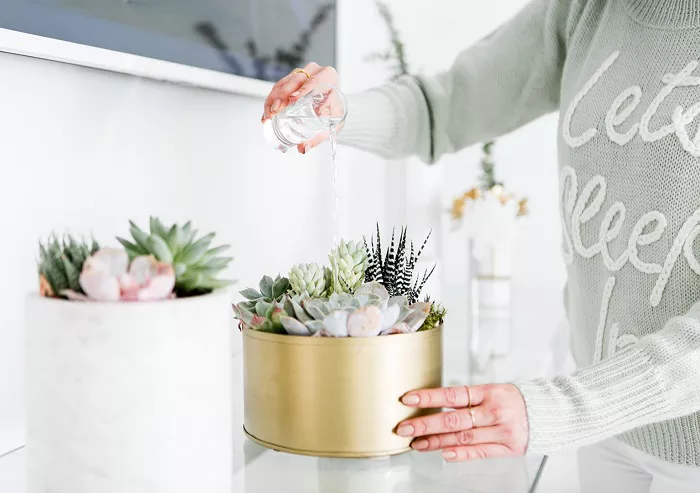Succulents are beloved for their unique shapes, vibrant colors, and low-maintenance nature. However, one of the most common mistakes gardeners make is improper watering. While these hardy plants can survive in tough conditions, they still need the right care to thrive. This guide will walk you through everything you need to know about watering succulents, ensuring they stay healthy and beautiful for years to come.
Understanding Succulents and Their Water Needs
What Makes Succulents Unique?
Succulents are plants that store water in their leaves, stems, or roots. This adaptation allows them to survive in arid environments where water is scarce. Popular varieties include aloe vera, echeveria, and jade plants. Because they store water, they don’t need frequent watering like other houseplants. Overwatering is the number one cause of succulent death, so understanding their needs is crucial.
How Succulents Use Water?
Succulents absorb water through their roots and store it in their fleshy tissues. During dry periods, they rely on these reserves to survive. This means they prefer a “soak and dry” method—watering deeply but infrequently. Unlike other plants, they don’t need constant moisture in the soil. In fact, soggy soil can lead to root rot, a common issue for succulents.
When to Water Succulents
Signs Your Succulent Needs Water
Succulents give clear signals when they’re thirsty. Look for these signs:
Wrinkled or Shriveled Leaves: This is the most common indicator. The leaves lose their plumpness as the plant uses up its stored water.
Dry Soil: Stick your finger about an inch into the soil. If it feels completely dry, it’s time to water.
Dull Color: Healthy succulents have vibrant colors. If they appear dull or faded, they may need hydration.
Seasonal Watering Tips
Succulents have different watering needs depending on the season:
Spring and Summer: This is their active growing season. Water every 7-10 days, depending on the climate and soil.
Fall and Winter: Succulents enter a dormant phase. Reduce watering to once every 2-4 weeks, as they require less moisture.
How to Water Succulents Correctly
The Soak and Dry Method
This is the gold standard for watering succulents. Here’s how to do it:
Water Thoroughly: Pour water evenly over the soil until it drains out of the bottom of the pot. This ensures the roots get enough moisture.
Let It Dry Completely: Wait until the soil is 100% dry before watering again. This mimics their natural environment and prevents overwatering.
Avoiding Common Mistakes
Don’t Mist Succulents: Misting doesn’t provide enough water and can lead to mold or rot.
Avoid Watering the Leaves: Water directly onto the soil to prevent water from pooling in the leaves, which can cause rot.
Use the Right Pot: Ensure your pot has drainage holes to let excess water escape.
Choosing the Right Soil and Pot
The Importance of Well-Draining Soil
Succulents need soil that drains quickly to prevent waterlogging. Use a cactus or succulent mix, or make your own by combining potting soil with sand or perlite. This creates a light, airy texture that allows water to flow through easily.
Selecting the Perfect Pot
The right pot can make a big difference:
Drainage Holes: Always choose a pot with drainage holes to avoid standing water.
Size Matters: A pot that’s too large can hold excess moisture, while one that’s too small may restrict growth. Pick a pot that’s slightly larger than the plant’s root ball.
Material: Terracotta pots are ideal because they absorb excess moisture and allow the soil to dry faster.
Watering Succulents Indoors vs. Outdoors
Indoor Succulents
Indoor succulents typically need less frequent watering because they’re protected from the elements. However, they may dry out faster in heated or air-conditioned environments. Monitor the soil closely and adjust your watering schedule as needed.
Outdoor Succulents
Outdoor succulents are exposed to more variables, such as rain, wind, and sunlight. In rainy climates, you may not need to water them at all. In hot, dry areas, you might need to water more often. Always check the soil before watering to avoid overdoing it.
Troubleshooting Watering Issues
Overwatering
Overwatering is the most common problem. Signs include:
Yellowing Leaves: This indicates the roots are drowning.
Mushy Stems or Leaves: A sign of rot caused by too much moisture.
Foul Smell: Rotting roots can produce a bad odor.
If you suspect overwatering, stop watering immediately. Remove the plant from its pot, trim any rotten roots, and let it dry out before repotting in fresh soil.
Underwatering
While less common, underwatering can also harm succulents. Signs include:
Dry, Crispy Leaves: The plant is dehydrated.
Stunted Growth: Lack of water slows down growth.
If your succulent is underwatered, give it a thorough soak and adjust your watering schedule.
Advanced Tips for Healthy Succulents
Watering Based on Climate
Your local climate plays a big role in how often you should water:
Humid Climates: Water less frequently, as the air holds more moisture.
Dry Climates: Water more often, as the soil dries out faster.
Using a Moisture Meter
A moisture meter can take the guesswork out of watering. Insert it into the soil to check the moisture level. Water only when the meter reads “dry.”
Fertilizing and Watering
Succulents don’t need much fertilizer, but if you choose to feed them, do so during the growing season (spring and summer). Water the plant before applying fertilizer to prevent root burn.
Conclusion
Watering succulents doesn’t have to be complicated. By understanding their unique needs and following the soak and dry method, you can keep your plants healthy and thriving. Remember to adjust your watering schedule based on the season, climate, and environment. With a little care and attention, your succulents will reward you with their stunning beauty and resilience. Happy gardening!


